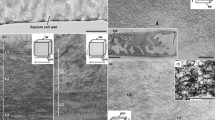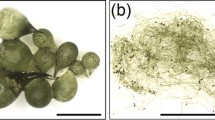Summary
Glaucocystis is an apoplastidic alga related to Oocystis (Chlorococcales) containing endosymbiontic blue-green algae. The cell walls and cellulose fibrils of two species were studied with the electron microscope in thin sections and by means of the negative staining technique. The walls are composed of several lamellae. Each lamella consists of two layers of cellulose microfibrils. In young walls the fibrils are masked by a dense matrix. In older envelopes of autospore mother cells the matrix is partly disintegrated; the fibrils are loosened and can therefore be seen directly. The microfibrils in one layer are oriented in a parallel pattern. They are partly interwoven with the microfibrils of the other layer and cross them at an angle of about 90°. In successive lamellae the direction of the micelles mostly changes by about 45°. The microfibrils are flat bands which are seldom broader than 20 nm, and their average length is calculated to be about 10 μ. Although they are composed of two or more elementary fibrils, they nevertheless seem to be relatively homogenous structures. Their elastic extensibility is about 2,3%. The elementary fibrils are tapered; the ends are about 3 nm broad, while the middle part measures up to 10 nm.
The results are discussed in relation to other observations on cellulose fibrils, and on the cell wall structure of other Chlorococcales.
Zusammenfassung
Die Zellwände und Cellulosefibrillen von Glaucocystis wurden elektronenmikroskopisch an Dünnschnitten und mit dem Negativ-Kontrast-Verfahren untersucht. Die Zellwände sind aus mehreren Lamellen zusammengesetzt. Die Lamellen bestehen aus einer Doppellage teilweise miteinander verwobener Mikrofibrillen in Paralleltextur; die beiden Lagen überkreuzen sich ungefähr rechtwinklig. Gegenüber der nächsten Lamelle ist die Streichrichtung meistens um etwa 45° gedreht.
In jungen Wänden sind die Celluloseelemente in eine dichte Matrix eingebettet und so markiert. In alten Autosporenmutterzell-Hüllen ist die Struktur aufgelockert; die Cellulose ist teilweise freigelegt und unmittelbar darstellbar. Die Mikrofibrillen sind abgeplattet und nur selten breiter als 20 nm. Ihre Länge wurde indirekt ermittelt; sie beträgt durchschnittlich etwa 10 μ.
Die Mikrofibrillen bestehen aus zwei (oder mehr) mit ihren Schmalseiten nebeneinander liegenden Elementarfibrillen; sie scheinen aber dennoch ein relativ homogenes Ganzes zu bilden. Ihre elastische Dehnbarkeit beträgt etwa 2,3%. Die Elementarfibrillen haben lang auslaufende, spitze Enden (Minimalbreite etwa 3 nm, in der Mitte des Fadens etwa 10 nm).
Die Ergebnisse werden mit anderen Angaben über den Bau der Mikro- und Elementarfibrillen und mit Befunden über die Struktur der Zellwände von Chlorococcalen verglichen.
Similar content being viewed by others
Literatur
Bisalputra, T., and T.E. Weier: The cell wall of Scenedesmus quadricauda. Amer. J. Bot. 50, 1011–1019 (1963).
Brenner, S., and R.W. Horne: A negative staining method for high resolution electron microscopy of viruses. Biochim. biophys. Acta (Amst.) 34, 103–110 (1959).
Colvin, J.R.: The size of the cellulose microfibril. J. Cell Biol. 17, 105–109 (1963).
—, and D.T. Dennis: The shape of the tips of growing bacterial cellulose microfibrils and its relation to the mechanism of cellulose biosynthesis. Canad. J. Microbiol. 10, 763–767 (1964).
Frei, D., and R.D. Preston: Cell wall organization and wall growth in the filamentous green algae Cladophora and Chaetomorpha. Proc. roy. Soc. B 154, 70–94 (1961).
Frey-Wyssling, A.: Die pflanzliche Zellwand. Berlin-Göttingen-Heidelberg: Springer 1959.
Geitler, L.: Der Zellbau von Glaucocystis Nostochinearum und Gloeochaete Wittrockiana und die Chromatophoren-Symbiosetheorie von Mereschkowsky. Arch. Protistenk. 47, 1–24 (1923).
—: Syncyanosen. In: W. Ruhland, Handbuch der Pflanzenphysiologie, Bd XI, S. 530–545, Berlin-Göttingen-Heidelberg: Springer 1959.
Günther, J.: Elektronenmikroskopische Untersuchungen an der keimenden Spore von Funaria hygrometrica. J. Ultrastruct. Res. 4, 304–331 (1960).
Hess, K., u. H. Mahl: Elektronenoptischer Nachweis großer Perioden bei Kunststoff-und Cellulosefasern. Naturwissenschaften 41, 86 (1954).
Manley, R.St.J.: Fine structure of native cellulose microfibrils. Nature (Lond.) 204, 1155–1157 (1964).
Millman, B., and J.R. Colvin: The formation of cellulose microfibrils by Acetobacter xylinum in agar surfaces. Canad. J. Microbiol. 7, 383–387 (1961).
Moner, J.G., and G.B. Chapman: Cell wall formation in Pediastrum biradiatum as revealed by the electron microscope. Amer. J. Bot. 50, 992–998 (1963).
Mühlethaler, K.: Die Feinstruktur der Zellulosemikrofibrillen. Beih. Z. schweiz. Forstv. 30, 55–64 (1960).
Northcote, D.H., K.J. Goulding, and R.W. Horne: The chemical composition and structure of the cell wall of Chlorella pyrenoidosa. Biochem. J. 70, 391–397 (1958).
———: The chemical composition and structure of the cell wall of Hydrodictyon africanum Yaman. Biochem. J. 77, 503–508 (1960).
Ohad, I., D. Danon, and S. Hestrin: Synthesis of cellulose by acetobacter xylinum. V. Ultrastructure of polymer. J. Cell Biol. 12, 31–46 (1962).
Parker, B.C.: The structure and chemical composition of cell walls of three Chlorophycean algae. Phycologia 4, 63–74 (1964).
Preston, R.D.: Die Struktur pflanzlicher Polysaccharide. Endeavour 23, 153–159 (1964).
Reynolds, D.S.: The use of lead citrate at high pH as an electron-opaque stain in electron microscopy. J. Cell Biol. 17, 208–212 (1963).
Soeder, C.J.: Elektronenmikroskopische Untersuchungen an ungeteilten Zellen von Chlorella fusca Shihira et Krauss. Arch. Mikrobiol. 47, 311–324 (1964).
Treiber, E., S. Asunmaa u. H. Meier: Der übermolekulare Aufbau der Cellulose und die Textur der Zellwände. In: E. Treiber, Chemie der Pflanzenzellwand, S. 167–223. Berlin-Göttingen-Heidelberg: Springer 1957.
Vogel, A.: Zur Feinstruktur von Ramie. Makromol. Chem. 11, 111–130 (1953).
Author information
Authors and Affiliations
Rights and permissions
About this article
Cite this article
Schnepf, E. Struktur der Zellwände und Cellulosefibrillen Bei Glaucocystis . Planta 67, 213–224 (1965). https://doi.org/10.1007/BF00385509
Received:
Issue Date:
DOI: https://doi.org/10.1007/BF00385509




